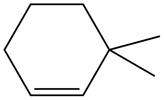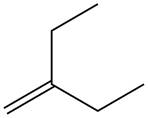
Concept explainers
Draw all constitutional isomers formed when each
a. b.
b. c.
c. 
(a)
Interpretation: The constitutional isomer formed by the reaction of given alkene with
Concept introduction: The reaction of alkene with
Answer to Problem 15.18P
The constitutional isomers formed by the reaction of given alkene with

Explanation of Solution
The reaction of alkene with
The given alkene is shown below.

Figure 1
The general steps involved in the reaction of allylic bromination with
• The first step is the initiation of bromine radical.
• The next step is the propagation in which generation of allylic radical take place.
• In third step, allylic radical reacts with
The constitutional isomer formed by the reaction of given alkene with

Figure 2
Therefore, the constitutional isomers formed for the given reaction are
The constitutional isomers formed by the reaction of given alkene with
(b)
Interpretation: The constitutional isomer formed by the reaction of given alkene with
Concept introduction: The reaction of alkene with
Answer to Problem 15.18P
The constitutional isomers formed by the reaction of given alkene with

Explanation of Solution
The reaction of alkene with
The given alkene is shown below.

Figure 3
The general steps involved in the reaction of allylic bromination with
• The first step is the initiation of bromine radical.
• The next step is the propagation in which generation of allylic radical take place.
• In third step, allylic radical reacts with
The constitutional isomer formed by the reaction of given alkene with

Figure 4
Therefore, the constitutional isomers formed for the given reaction are
The constitutional isomers formed by the reaction of given alkene with
(c)
Interpretation: The constitutional isomer formed by the reaction of given alkene with
Concept introduction: The reaction of alkene with
Answer to Problem 15.18P
The constitutional isomers formed by the reaction of given alkene with

Explanation of Solution
The reaction of alkene with
The given alkene is shown below.

Figure 5
The general steps involved in the reaction of allylic bromination with
• The first step is the initiation of bromine radical.
• The next step is the propagation in which generation of allylic radical take place.
• In third step, allylic radical reacts with
The constitutional isomer formed by the reaction of given alkene with

Figure 6
Therefore, the constitutional isomers formed for the given reaction are
The constitutional isomers formed by the reaction of given alkene with
Want to see more full solutions like this?
Chapter 15 Solutions
PKG ORGANIC CHEMISTRY
- true or false, given that a 20.00 mL sample of NaOH took 24.15 mL of 0.141 M HCI to reach the endpoint in a titration, the concentration of the NaOH is 1.17 M.arrow_forwardin the bromothymol blue experiment, pKa was measured. A closely related compound has a Ka of 2.10 x 10-5. What is the pKa?a) 7.1b) 4.7c) 2.0arrow_forwardcalculate the equilibrium concentration of H2 given that K= 0.017 at a constant temperature for this reaction. The inital concentration of HBr is 0.050 M.2HBr(g) ↔ H2(g) + Br2(g)a) 4.48 x 10-2 M b) 5.17 x 10-3 Mc) 1.03 x 10-2 Md) 1.70 x 10-2 Marrow_forward
- true or falsegiven these two equilibria with their equilibrium constants:H2(g) + CI2(l) ↔ 2HCI(g) K= 0.006 CI2(l) ↔ CI2(g) K= 0.30The equilibrium contstant for the following reaction is 1.8H2(g) + CI2 ↔ 2HCI(g)arrow_forwardI2(g) + CI2(g) ↔ 2ICIK for this reaction is 81.9. Find the equilibrium concentration of I2 if the inital concentration of I2 and CI2 are 0.010 Marrow_forwardtrue or false,the equilibrium constant for this reaction is 0.50.PCI5(g) ↔ PCI3(g) + CI2(g)Based on the above, the equilibrium constant for the following reaction is 0.25.2PCI5(g) ↔. 2PCI3(g) + 2CI2(g)arrow_forward
- true or false, using the following equilibrium, if carbon dioxide is added the equilibrium will shift toward the productsC(s) + CO2(g) ↔ 2CO(g)arrow_forward2S2O2/3- (aq) + I2 (aq) ---> S4O2/6- (aq) +2I- (aq) Experiment I2 (M) S2O3- (M) Initital Rate (M/s) 1 0.01 0.01 0.0004 2 0.01 0.02 0.0004 3 0.02 0.01 0.0008 Calculate the overall order for this reaction using the table data a) 3b) 0c) 2d) 1arrow_forwardthe decomposition of N2O5 is the first order with a half-life of 1.98 minutes. If the inital concentration of N2O5 is 0.200 M, what is the concentration after 6 minutes?a) 0.612 Mb) 0.035 Mc) 0.024 Md) 0.100 Marrow_forward
- 20.00 mL of 0.150 M HCI is titrated with 0.075 M NaOH. What volume of NaOH is needed?a) 50 mLb) 20 mLc) 40 mLd) 26.66 mLarrow_forward20.00 mL of 0.150 M NaOH is titrated with 37.75 mL of HCI. What is the molarity of the HCI?a) 0.150 Mb) 0.079 Mc) 0.025 Md) 0.050 Marrow_forwardin the following reaction, the OH- acts as which of these?NO2- (aq) + H2O (l) ⇌ OH- (aq) + HNO2 (aq)a) not a weak acidb) basec) acidarrow_forward
 ChemistryChemistryISBN:9781305957404Author:Steven S. Zumdahl, Susan A. Zumdahl, Donald J. DeCostePublisher:Cengage Learning
ChemistryChemistryISBN:9781305957404Author:Steven S. Zumdahl, Susan A. Zumdahl, Donald J. DeCostePublisher:Cengage Learning ChemistryChemistryISBN:9781259911156Author:Raymond Chang Dr., Jason Overby ProfessorPublisher:McGraw-Hill Education
ChemistryChemistryISBN:9781259911156Author:Raymond Chang Dr., Jason Overby ProfessorPublisher:McGraw-Hill Education Principles of Instrumental AnalysisChemistryISBN:9781305577213Author:Douglas A. Skoog, F. James Holler, Stanley R. CrouchPublisher:Cengage Learning
Principles of Instrumental AnalysisChemistryISBN:9781305577213Author:Douglas A. Skoog, F. James Holler, Stanley R. CrouchPublisher:Cengage Learning Organic ChemistryChemistryISBN:9780078021558Author:Janice Gorzynski Smith Dr.Publisher:McGraw-Hill Education
Organic ChemistryChemistryISBN:9780078021558Author:Janice Gorzynski Smith Dr.Publisher:McGraw-Hill Education Chemistry: Principles and ReactionsChemistryISBN:9781305079373Author:William L. Masterton, Cecile N. HurleyPublisher:Cengage Learning
Chemistry: Principles and ReactionsChemistryISBN:9781305079373Author:William L. Masterton, Cecile N. HurleyPublisher:Cengage Learning Elementary Principles of Chemical Processes, Bind...ChemistryISBN:9781118431221Author:Richard M. Felder, Ronald W. Rousseau, Lisa G. BullardPublisher:WILEY
Elementary Principles of Chemical Processes, Bind...ChemistryISBN:9781118431221Author:Richard M. Felder, Ronald W. Rousseau, Lisa G. BullardPublisher:WILEY





